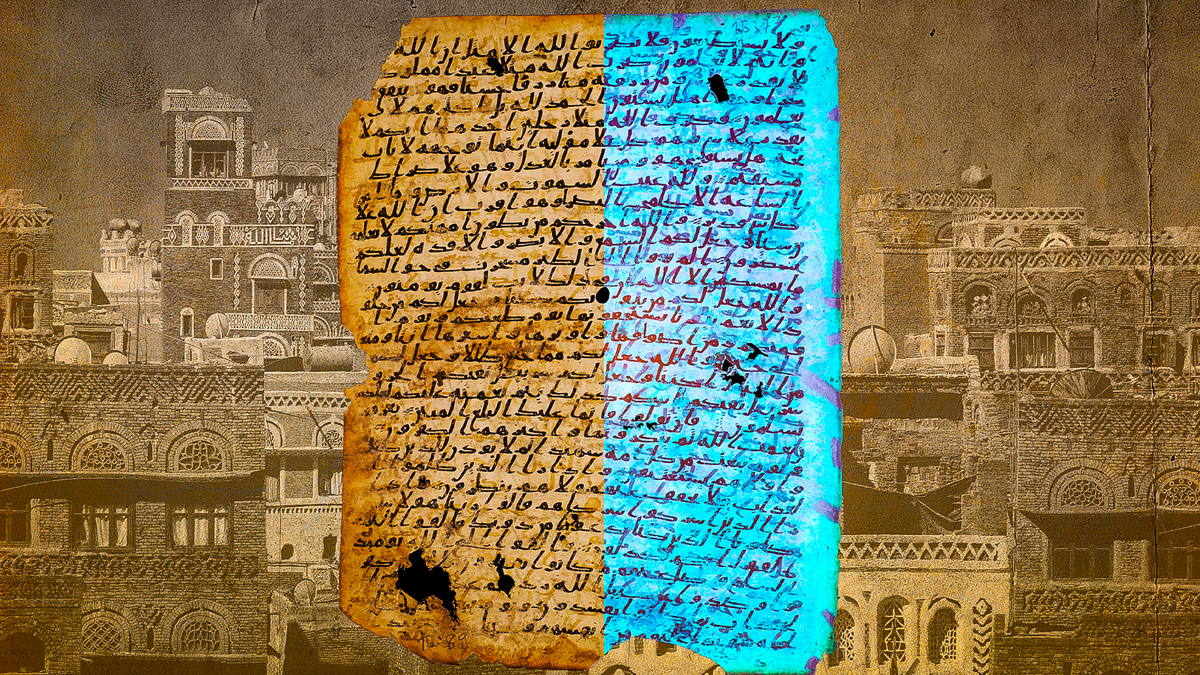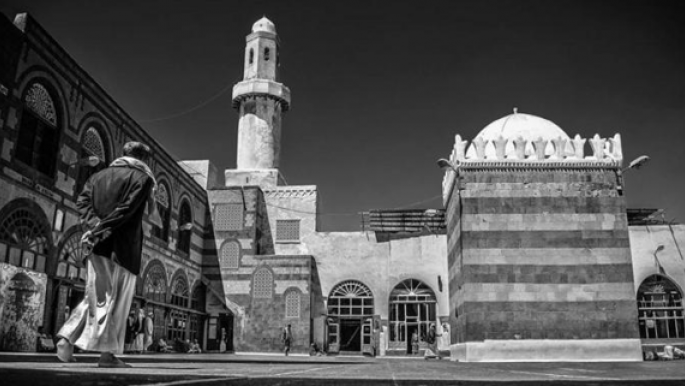
The Sanaa Palimpsest: A truly fascinating Quranic manuscript
Éléonore Cellard
12 July, 2022
The Sanaa Palimpsest has a number of unique characteristics, not least as an enduring artefact of Quranic scribal methods and of Islamic heritage within Yemen. Yet deciphering the text poses theological quandaries surrounding Quranic tradition.ShareFlipboardRedditWhatsAppTwitterFacebook
In early 1973, a team of workers who were renovating the Grand Mosque of Sanaa in Yemen came upon a hidden trove of manuscripts between the ceiling and the roof.
Reduced to fragments, the books had become unusable and were abandoned, probably after the reorganisation of the mosque library.
While a German-Yemeni team was cataloguing and restoring the tens of thousands of manuscript fragments in the 1980s, they found a unique manuscript – a palimpsest – that almost certainly dates from the first century of Islam.
"The most unusual feature of the Sanaa manuscript is that both texts – the original and the newer, superimposed text – are fragments of the same text, the Quran, and were separated by several decades apart"
Spanning a variety of cultures, palimpsests – texts written over an earlier, erased text that is often nevertheless visible – were a common method of recycling precious parchment and other materials.
The most unusual feature of the Sanaa manuscript is that both texts – the original and the newer, superimposed text – are fragments of the same text, the Quran, and were separated by several decades apart.
According to tradition, the canonical Quran is an irreproachable record of the words revealed to the Prophet Muhammad by God in the mid-seventh century CE. In which case, the obvious question is why the original underlying text was erased only to be replaced a few decades later.

The courtyard of the Great Mosque of Sanʿāʾ
Before considering this puzzle, I will describe the physical traits of the manuscript, particularly the earlier text. The original script is an accurate copy of the Quran written on parchment.
It resembles other large volumes found in mosques – but not school exercises on separate leaves, as has been recently suggested by Asma Hilali. The eighty leaves of the Sanaa manuscript that scholars were able to meticulously reassemble constitute roughly half of the complete original Quranic text.
The writing styles and habits of the two scribes who contributed to the copying suggest that it was written in the latter half of the 7th century.
Carbon 14 dating, however, suggests the first half of the century, although interpreting these data is complex because carbon dating records only when the sheep whose skin became the parchment died instead of when the original text was copied by the scribes.
Before considering this puzzle, I will describe the physical traits of the manuscript, particularly the earlier text. The original script is an accurate copy of the Quran written on parchment.
It resembles other large volumes found in mosques – but not school exercises on separate leaves, as has been recently suggested by Asma Hilali. The eighty leaves of the Sanaa manuscript that scholars were able to meticulously reassemble constitute roughly half of the complete original Quranic text.
The writing styles and habits of the two scribes who contributed to the copying suggest that it was written in the latter half of the 7th century.
Carbon 14 dating, however, suggests the first half of the century, although interpreting these data is complex because carbon dating records only when the sheep whose skin became the parchment died instead of when the original text was copied by the scribes.
RELATEDCultureN.A. Mansour
Intriguingly, it also becomes apparent that the underlying text, partly deciphered with the help of images in ultraviolet light, includes previously unknown textual variants of the Quran.
Dozens of other Quranic manuscripts dating from the same period – or even older – found in other mosques around the Islamic world faithfully transmit the canonical text, with only slight orthographic differences.
The original text of the Sanaa manuscript, however, contains important differences such as synonyms for certain words and omissions, additions, and transpositions of words or groups of words within verses.
The Surahs are also arranged differently from the canonical Quran, although they nevertheless proceed, in canonical fashion, from the longest to the shortest.

The discovery of the manuscripts in the early 1970s (from P. Costa, La moschea grande di Ṣan‘ā’, Annali, 1974)
Ultimately, however, the deciphered underlying text closely resembles the modern-day Quran, and these slight variations do not interfere with the meaning.
Is it possible that the earlier version was more focused on meaning than on flawlessly conveying literal Quranic text?
This hypothesis is the most interesting – and controversial – feature of the Sanaa palimpsest and has provoked lively debates among specialists because it seems to be the only known example of this type of transmission.
In any case, the older, erased version was unquestionably replaced with a more canonical version, leaving an air of mystery surrounding the erased text.
Was it an earlier version than the canonical text, produced by the circle of the companions of the Prophet? Is it a surviving example of a scribal tradition that somehow coexisted with the canonical text and that dared to take a looser approach to the revealed Word, whether deliberately or not?

Ultimately, however, the deciphered underlying text closely resembles the modern-day Quran, and these slight variations do not interfere with the meaning.
Is it possible that the earlier version was more focused on meaning than on flawlessly conveying literal Quranic text?
This hypothesis is the most interesting – and controversial – feature of the Sanaa palimpsest and has provoked lively debates among specialists because it seems to be the only known example of this type of transmission.
In any case, the older, erased version was unquestionably replaced with a more canonical version, leaving an air of mystery surrounding the erased text.
Was it an earlier version than the canonical text, produced by the circle of the companions of the Prophet? Is it a surviving example of a scribal tradition that somehow coexisted with the canonical text and that dared to take a looser approach to the revealed Word, whether deliberately or not?

The Sanʿāʾ palimpsest, photographed under normal white light (left) and UV light (right.
(Sanaa, Dar al-makhutat, 01-27.1, f.5a). [Used with the permission of CNRS, DATI]
These questions should be examined against the background of the entire contemporary corpus. Do the world’s Quranic manuscripts represent the history of the Quran, or, on the contrary, are they only one dimension of Quranic tradition?
Did other “non-canonical” manuscripts exist, and if so, were they carefully eliminated, generation after generation? What is clear is that the Sanaa palimpsest survived because it was hidden – not simply in a false ceiling in a Yemeni mosque, but as a ghostly, partially decipherable version that lies under the canonical text.
These questions should be examined against the background of the entire contemporary corpus. Do the world’s Quranic manuscripts represent the history of the Quran, or, on the contrary, are they only one dimension of Quranic tradition?
Did other “non-canonical” manuscripts exist, and if so, were they carefully eliminated, generation after generation? What is clear is that the Sanaa palimpsest survived because it was hidden – not simply in a false ceiling in a Yemeni mosque, but as a ghostly, partially decipherable version that lies under the canonical text.
RELATEDCultureKaren Dabrowska
Much research remains before scholars will be able to definitively answer these questions. Including a thorough, technologically sophisticated analysis of this special manuscript, half of which is still stored by the Library of Religious Endowments at the Great Mosque of Sanaa and has not been yet properly photographed.
If the war in the region ends, curators and restorers will ultimately make it possible to decipher the entire underlying text and draw conclusions about the habits and practices of the scribes who copied it.
The findings of this research will enrich our understanding of the circumstances surrounding the creation, use, and recycling of this unique Quranic manuscript.
Eléonore Cellard is a French scholar and researcher who specializes in Arabic palaeography and codicology, particularly Quranic manuscripts.
Follow her on Twitter: @CellardEleonore
No comments:
Post a Comment